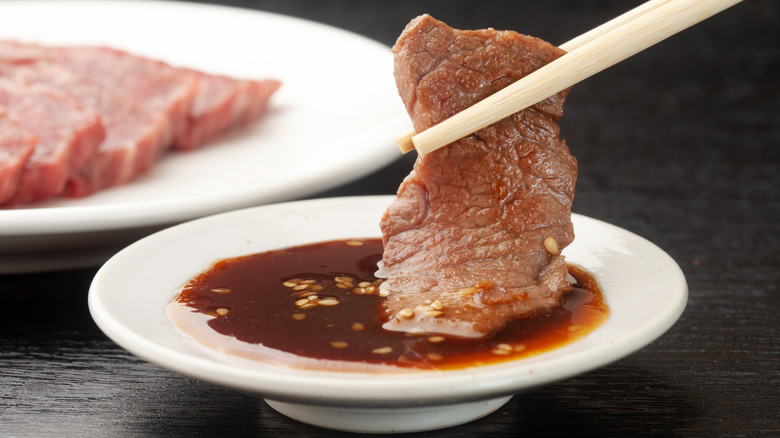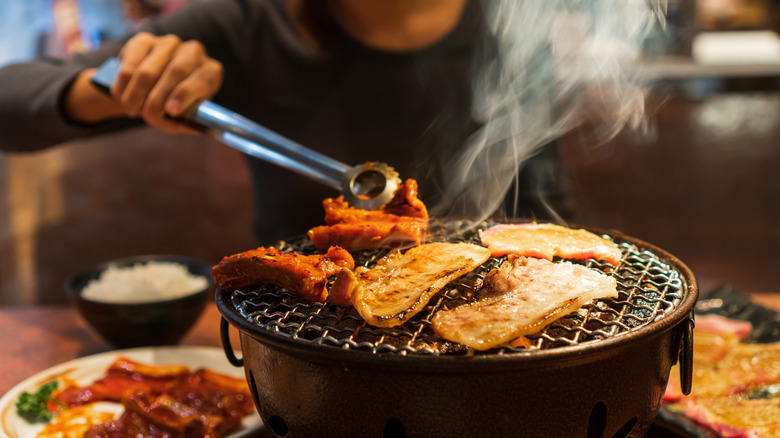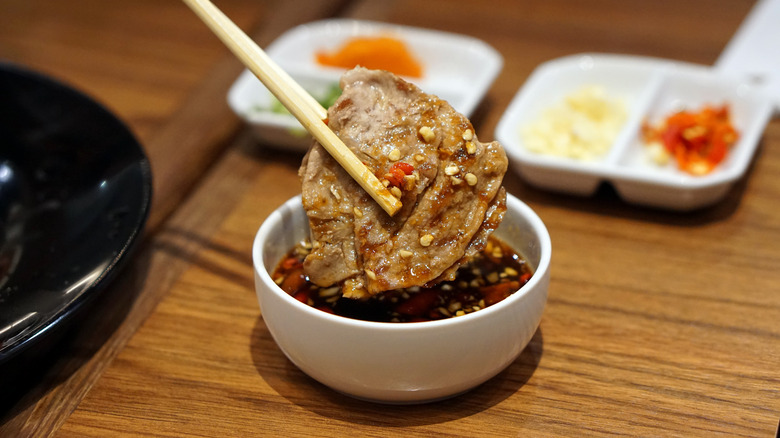What Is Yakiniku Sauce And What Kind Of Meat Should You Serve It With?
One of the most important elements of Japanese cuisine is tare. Tare is a broad term used to reference a number of sauces and glazes that are generally based around four ingredients: sake, mirin, sugar, and shoyu (Japanese-style soy sauce). The most internationally famous type of tare is teriyaki sauce, but the popular chicken and beef teriyaki dishes found in the United States are really American inventions. Japanese cooks traditionally use teriyaki when grilling fish; for meats like beef and chicken, they use an entirely different type of tare called yakiniku sauce.
Yakiniku sauce is made from the fundamental tare ingredients of shoyu, mirin, sake, and usually sugar, although some recipes omit the latter. It also includes garlic, sesame seeds, and often sesame oil. Yakiniku sauce is very versatile, and different cooks have different takes on it. Some versions include ginger, miso, chili powder, and even fruits such as apple, which can further enhance the sauce's sweetness.
Yakiniku translates to English as "grilled meat" and it actually refers to a type of cooking style from which the sauce takes its name. Yakiniku is meat cooked over high heat on a tabletop grill and it's a popular category of Japanese street food. The most iconic yakiniku dish is thinly sliced steak, but practically any cut of beef can be used, as can pork and chicken. The sauce is most commonly used for dipping freshly grilled pieces of meat into but it can also serve as a marinade or glaze.
Yakiniku is the Japanese food you've been sleeping on
The term "yakiniku" was popularized by Japanese writer Kanagaki Robun in his 1872 book "Seiyo Ryori-tsu" (西洋料理通, or "Connoisseur of Western-Style Cooking"). It was originally used in reference to Western barbecue food, like that of the United States. However, not many Japanese people were actually eating meat at that time; 1872 had just marked the end of a 1,200-year ban on meat eating in Japan that was originally adopted as a Buddhist practice. Regular consumption of meat wouldn't catch on at large in Japan for a few more decades, but it eventually did with the help of immigrants.
Modern yakiniku is heavily inspired by Korean barbecue. In the 1930s, Korean immigrants in Osaka introduced Japanese diners to classic grilled meat dishes like galbi and bulgogi. Yakiniku really took off in the years following WWII when Japan experienced severe food shortages. Japanese chefs habitually discarded less desirable cuts of beef and pork, such as offal. Koreans residing in Japan could obtain these discarded cuts cheaply, and use the grilling practices of their homeland to transform them into great meals.
Korean barbecue restaurants began popping up throughout Japan, but then the Korean War began. North and South Korea were divided, and so were the Korean restaurants in Japan. If Japanese people were unsure whether a certain Korean restaurant was affiliated with the North or South, they'd use "yakiniku" as a politically correct umbrella term. Eventually, Japanese chefs adopted the cuisine themselves.
How to use yakiniku sauce
Even in its most basic form, yakiniku sauce is an incredibly versatile and impactful addition to your culinary arsenal. You can buy it pre-bottled, but it is quite easy to make at home, where you can customize it to your liking. Yakiniku sauce is not constrained to a singular formula, and you can experiment with further ingredients to tweak its flavor profile. You can enhance the sauce's sweetness with blended or grated fruits such as apples or peaches, add an acidic tang with rice wine vinegar, deepen the umami with miso paste, or add a spicy kick with togarashi chili flakes.
You can approximate the yakiniku experience at home by thinly slicing a high-quality piece of steak and grilling it over the highest heat you can manage. You can use the sauce in three different ways: marinating the meat overnight in it, brushing it onto the meat while it cooks, or dipping pieces of grilled meat into it.
In Japan, the most acclaimed yakiniku chefs use the technique on wagyu beef. The Japanese cattle breed is revered for its tender, flavorful meat and it is perfectly suited for yakiniku when thinly sliced. It should be cooked quickly, and over high heat for the best results, and because wagyu beef is so flavorful on its own, it doesn't really need a marinade or glaze. The sauce is best used for dipping.


